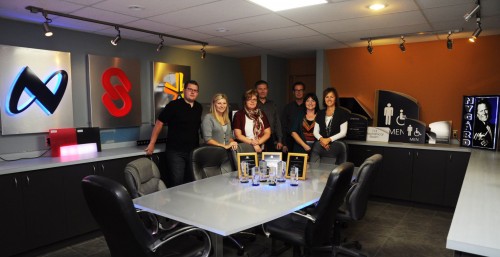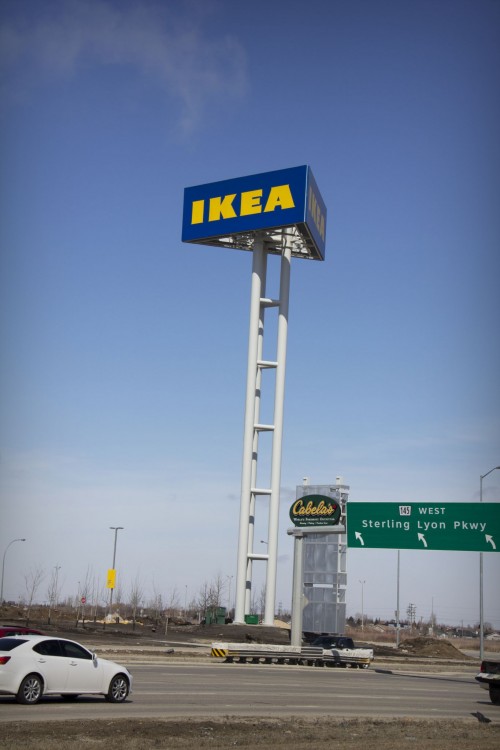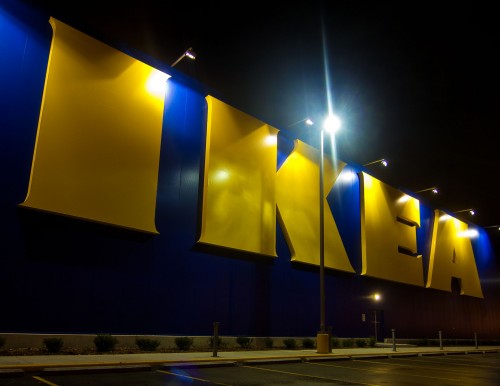Sign Shop Profile: Signex
by all | 11 September 2014 4:30 pm
 [1]
[1]Photos courtesy Signex
By Peter Saunders
When Signex was founded just outside Winnipeg in 1982, it was an offshoot of a family electrical contracting business, which already had experience working with lightboxes. Today, it is an award-winning, multifaceted company with the largest sign manufacturing facility in central Canada.
Learning the business
Pankratz Electric had been serving the local region since the 1960s when business customers began approaching the company with requests for electric sign products. With little more than an overhead projector and a spray gun, Signex began turning its lightboxes into completed signs.
“We were naïve enough to think it would be simple,” laughs Ken Pankratz, who would take over Signex in 1990 and remains its owner today. “There were a lot of challenges in learning how to create artwork and apply it. We had to hire people who knew that side of the business.”
While no one yet knew the Signex name, the company’s electrical background helped it reach out to more general contractors and, eventually, architects and real-estate developers involved in construction projects. Its first jobs included signs for a few local grocery stores.
The timing was also right for getting into the business, as strip malls were becoming increasingly popular, requiring continuous rows of signboxes. And with Canadian Standards Association (CSA) approval from day one, Signex also became a major supplier of signboxes to other sign companies.
“It’s been more co-operation than competition,” says Pankratz.
 [2]
[2]In 2013, Signex was commissioned to build pylons and other signs for Winnipeg’s new Ikea store.
Evolution of equipment
Over time, the company added a computer numerical control (CNC) router, wide-format printer, plotter, channel letter bender, braille/tactile character router, tungsten inert gas (TIG) welding machinery, laminators and rolling machines. About two years ago, it phased out neon and fluorescent lighting systems entirely, in favour of energy-efficient light-emitting diodes (LEDs).
“Signmaking is certainly an exciting business to be in if you enjoy change,” says Pankratz. “You always have to move forward, find new ways to do things and stay a step ahead of trends in technology. When I started, for example, channel letters were a lot of work, but now we have computer-controlled channel bending. Labour has decreased and precision has increased dramatically over the years.”
Indeed, computers and automation have helped Signex take on bigger and bigger jobs.
“We’re currently working on a project that incorporates an interactive LED display on a one-block long wall,” Pankratz says.
The tipping points
There have been several “tipping points,” as Pankratz puts it, that have helped raise the company’s profile. One such job involved signage for two Famous Players movie theatres, one in Winnipeg and the other in Calgary, in 1999 and 2000.
 [3]“That led us to do work for the MTS Centre,” he says, referring to Winnipeg’s major arena and entertainment venue, home to the National Hockey League’s (NHL’s) Winnipeg Jets, which opened in 2004.
[3]“That led us to do work for the MTS Centre,” he says, referring to Winnipeg’s major arena and entertainment venue, home to the National Hockey League’s (NHL’s) Winnipeg Jets, which opened in 2004.
Another milestone year was 2013, when Signex was commissioned to create signs for Winnipeg’s new Ikea store and for Investors Group (IG) Field, a stadium built for the Canadian Football League’s (CFL’s) Winnipeg Blue Bombers. IG Field will also host the CFL’s 2015 Grey Cup and help Canada host the 2015 Fédération Internationale de Football Association (FIFA) Women’s World Cup.
“We designed all of those signs in-house,” Pankratz says, “and there were more than 1,000 of them.”
A similarly large project now looms with the Canadian Museum for Human Rights (CMHR), scheduled to open in Winnipeg on September 20. Long in the planning, Signex will create wayfinding, tactile and braille signage for the first national museum ever to be built outside the National Capital Region. The company was pre-qualified for the project three years ago.
Spreading the word
Like many other sign shops, of course, Signex’s bread and butter are clients with larger chains of locations that all need their own signs.
“We don’t get much opportunity here in Winnipeg to land national accounts, as the work often goes wherever the client’s head office is,” Pankratz explains, “but the city is a transportation hub and we had a great run with Shoppers Drug Mart stores all across the Prairies a few years ago. We’ve also made signs for Husky Energy in the past. Our smaller clients include local credit unions.”
Winnipeg is not without its head offices, though, and one of Signex’s biggest clients today is Nygård International, which is based locally and has become one of the largest manufacturers and suppliers of women’s apparel anywhere in the world, with more than 200 retail locations throughout North America.
“Not much of our work is international, but with Nygård, our signs are in New York and California,” says Pankratz.
 [4]
[4]Investors Group Field, featuring Signex’s work, will host the CFL’s 2015 Grey Cup.
The key to growth
Signex started out with just two employees and a 185.8-m2 (2,000-sf) facility. Since then, it has expanded tenfold in both senses, with 20 employees—including salespeople, designers, technicians, fabricators and installers—and, by the end of this year, more than 1,858 m2 (20,000 sf) of space.
“We’re expanding and we’re always looking for new, talented people,” says Pankratz.
The key to the company’s success, its owner says, has been its strong base of clients who can make decisions early on in projects, rather than consider signage only at the last minute.
“You can solve a lot of problems at the front end,” Pankratz says, “and there can be a lot of innovation, because you get to discuss exactly what the architect wants to see. We get to work with very solid designs and materials. Since we’re so strong in that area now, we would like to do more design-build work in the future.”
- [Image]: http://www.signmedia.ca/wp-content/uploads/2014/09/Group.jpg
- [Image]: http://www.signmedia.ca/wp-content/uploads/2014/09/Ikea-Pylon-3.jpg
- [Image]: http://www.signmedia.ca/wp-content/uploads/2014/09/Ikea05.jpg
- [Image]: http://www.signmedia.ca/wp-content/uploads/2014/09/Investors04.jpg
Source URL: https://www.signmedia.ca/sign-shop-profile-signex/